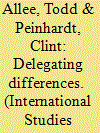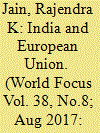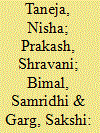|
|
|
Sort Order |
|
|
|
Items / Page
|
|
|
|
|
|
|
| Srl | Item |
| 1 |
ID:
095373


|
|
|
|
|
| Publication |
2010.
|
| Summary/Abstract |
Bilateral investment treaties (BITs) have become the dominant source of rules on foreign direct investment (FDI), yet these treaties vary significantly in at least one important respect: whether they allow investment disputes to be settled through the International Centre for the Settlement of Investment Disputes (ICSID). Through the compilation and careful coding of the text of nearly 1,500 treaties, we identify systematic variation in "legal delegation" to ICSID across BITs and explain this important variation by drawing upon a bargaining framework. Home governments prefer and typically obtain ICSID clauses in their BITs, particularly when internal forces push strongly for such provisions and when they have significantly greater bargaining power than the other signatory. Yet some home governments are less likely to insist upon ICSID clauses if they have historical or military ties with the other government. On the other hand, although host governments are often hostile toward ICSID clauses, particularly when sovereignty costs are high, they are more likely to consent to such clauses when they are heavily constrained by their dependence on the global economy. Our findings have significant implications for those interested in FDI, legalization, international institutions, and interstate bargaining.
|
|
|
|
|
|
|
|
|
|
|
|
|
|
|
|
| 2 |
ID:
154050


|
|
|
|
|
| Summary/Abstract |
This article provides a broad overview of relations between the European Economic Community (EEC)/European Union (EU) since the Treaty of Rome to the present. It discusses initial Indian perceptions of the EEC, the institutional architecture of dialogue and interaction and focuses on the convergence and divergence on a number of political issues, including global governance.
|
|
|
|
|
|
|
|
|
|
|
|
|
|
|
|
| 3 |
ID:
172302


|
|
|
|
|
| Summary/Abstract |
India and Nepal have traditionally shared a unique relationship of friendship and economic cooperation. The relationship is characterised by an open and people-friendly border and is built on shared historical, cultural, linguistic and ethnic links between people residing in India and Nepal.
With Nepal being a priority under India ‘Neighborhood First’ policy, strengthening the economic relationship holds immense significance and potential for both the countries. While the political relations between India and Nepal have been extensively studied, there is not much literature that explores the economic relationship between the two nations. This is an important issue to study, as India is Nepal’s largest export market, the biggest source of its imports, the top investor of foreign capital stock and among the largest donors of foreign aid. India also provides Nepal transit facility through its territory to access seaports for trading with the rest of the world.
Given this, the main objective of this article is to suggest policy measures, which can increase bilateral trade and investment between India and Nepal. The article analyses the bilateral trade patterns and estimates the maximum additional trade potential. A wide range of issues of importance pertaining to bilateral trade, including tariffs, levy of an agricultural reform fee, under utilisation of the tariff rate quota, non-tariff measures, issues related to Rules of Origin (ROO) and physical barriers to cross-border movement of goods are discussed. The trends and changing sectoral composition of India’s investment in Nepal and barriers and opportunities for Indian investment in Nepal are also analysed. The article concludes by charting a way forward for bolstering economic cooperation between the two countries by listing down recommendations for enhancing trade, addressing non-tariff barriers, upgrading infrastructure to improve connectivity and enhancing Indian FDI in Nepal.
|
|
|
|
|
|
|
|
|
|
|
|
|
|
|
|
|
|
|
|
|